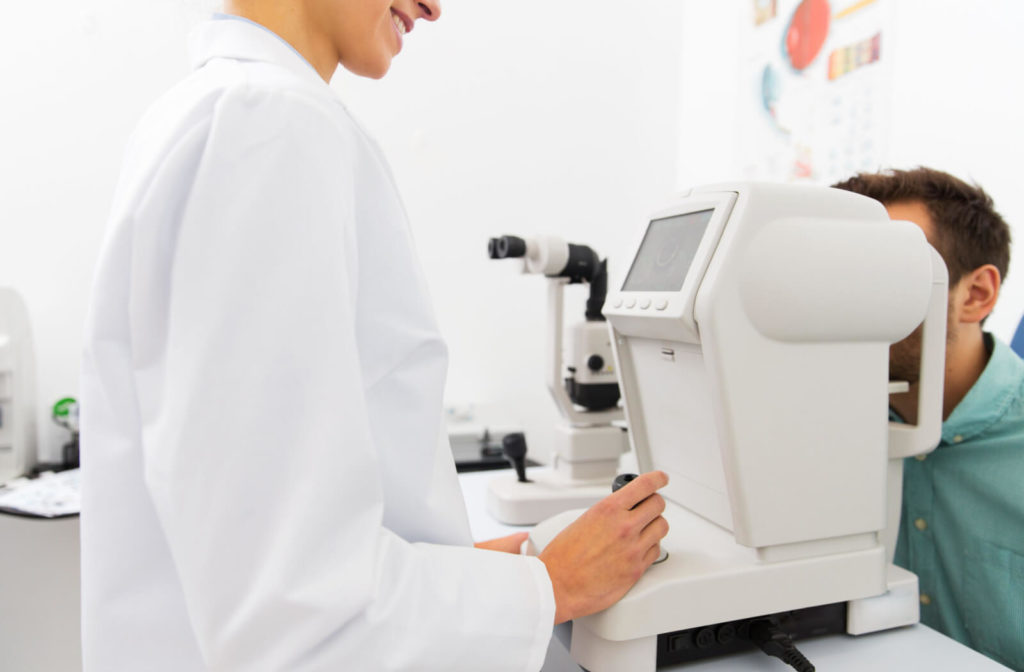Whether new to contacts or updating your prescription, you’ll need a contact lens exam and fitting. Even if you already have a prescription for your glasses, you’ll need a separate one for contact lenses. It’s important to get this right, as poor-fitting lenses can be ineffective in fixing your vision or result in irritation.
A contact lens exam doesn’t have to be intimidating. It’s the same as your standard eye exam, but with a few more specialized tests thrown in. You can expect to have your cornea measured, and the health of your tear film assessed to fit the perfect lenses for you.
Contact Lens Eye Exams
For an adult over 20, you should plan to have an eye exam every 2 or 3 years. When you’re over 40, you should have one every 2 years, and over 65, you should have an annual eye exam. These exams are important for eye and vision health, but a contact lens exam and fitting aren’t included in a standard eye exam, so you’ll need to ask your optometrist for one.
You’ll likely be familiar with many of the tests performed during your contact lens exam, such as a visual acuity test. This test includes having you read out letters or symbols on an eye chart or display placed 20 feet away, one eye at a time. The eye doctor will also need to measure your refractive error to determine your prescription.
You may also be asked questions about your eye health history and preferences regarding contact lenses, especially if you’ve never had contact lenses before, as you’ll need contact lenses that suit your lifestyle.
Types of Contact Lenses
Contact lenses aren’t one size fits all, and it’s not just even about their size. There are many different types of contact lenses available. Some are better at correcting complicated refractive errors like astigmatism. Others are even capable of slowing the progression of nearsightedness in children. You’ll have to discuss with your eye doctor which is best for your unique needs.
These are some of the basic types of contact lenses available:
Hard Contact Lenses
Hard contact lenses can correct refractive errors. They’re made of a gas-permeable material that allows oxygen to reach the cornea (the clear front dome of your eye). Some wearers may have problems when the cornea doesn’t get enough oxygen, and this type of lens may help with that.
Conventional Hard Lenses
Conventional hard lenses (PMMA) are made of relatively stiff plastic. They’re inexpensive and durable. However, due to their inability to mold to the eye and reduce oxygen to the cornea, they can be uncomfortable to wear.
Rigid Gas-Permeable (RGP) Lenses
A middle ground between the first 2, RGP lenses are less durable than conventional hard lenses but can be more comfortable. Some types may even be designed for extended wear, though many eye specialists advise against wearing contacts while sleeping.
Soft Contact Lenses
Made of silicone hydrogel, soft contact lenses are made of very soft and flexible plastic. These lenses are fragile and require cleaning every night, but many wearers find them more comfortable than RGP lenses. Whether you pick soft or rigid lenses, there are pros and cons to both that you should discuss with your doctor.

How an Optometrist Measures Your Eyes
Just as finding the right shoe requires measuring your feet, finding the right contact lenses means measuring your eyes.
Your eye doctor will start by measuring the curvature of your cornea using an instrument called a keratometer. You’ll sit facing the machine with your head and chin resting on a brace, at which point a light is shined in your eye. This machine analyzes the light reflections off your cornea, detecting any scattering to help your eye doctor figure out the proper size for your contact lenses.
While this can give specific details on a limited section of the cornea, it’s possible to get details on your entire cornea using a corneal topographer. By reflecting light off your cornea, doctors can now create a topographical map of your eye that helps fit contact lenses that offer optimal vision.
You also may have a tear film evaluation, in which your eye doctor will use a small strip of paper placed beneath your eye. This will test your body’s ability to produce tears. For eyes prone to dryness, your eye doctor may recommend wearing soft lenses with moisture technology.
What If Your Eyes Are Hard to Fit?
Certain eye conditions can make it difficult to wear contact lenses, like:
- Keratoconus
- Astigmatism
- Dry eyes
- Giant papillary conjunctivitis (GPC)
- Post-refractive surgery
- Presbyopia
But this doesn’t mean you’re out of luck. There may be options for you to still be able to wear contact lenses. If you have any of these conditions, contact your eye doctor to discuss the types of lenses out there.
Caring for Your Contact Lenses
Now that you have your prescription and your first box of contacts, you need to make sure you take care of them. Your eye doctor will take you through the process of inserting your lenses. For many, this can be uncomfortable the first time.
It’s best to follow your doctor’s recommendations, like only wearing your contacts for the prescribed time and using the appropriate cleaning system. Some contacts are designed for daily use, while others have been approved for extended wear. However, many eye doctors still recommend removing them every day.
There are also disposable contacts intended to be worn for a set amount of time before being discarded. The best contact lens supports your eye health and your lifestyle. Once again, it’s a discussion you’ll have with your eye doctor.
Booking a Fitting
Contact lenses can give a much-needed break for those who wear glasses. While a contact lens exam is more involved than your standard eye exam, it’s essential for ensuring your contacts provide you with the vision correction you need while fitting comfortably into your lifestyle.
If you’re interested in contact lenses, contact our team at Discover Eyecare to book an appointment for a contact lens fitting.



